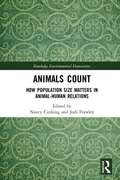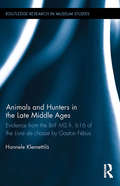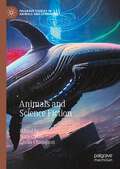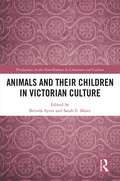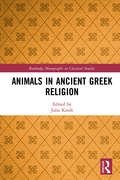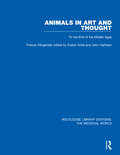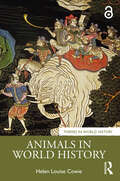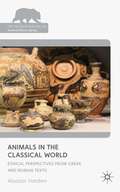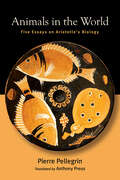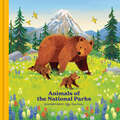- Table View
- List View
Animal, Vegetable, Junk: A History of Food, from Sustainable to Suicidal
by Mark BittmanFrom hunting and gathering to GMOs and ultraprocessed foods, this expansive tour of human history rewrites the story of our species—and points the way to a better future.The history of Homo sapiens is usually told as a story of technology or economics. But there is a more fundamental driver: food. How we hunted and gathered explains our emergence as a new species and our earliest technology; our first food systems, from fire to agriculture, tell where we settled and how civilizations expanded. The quest for food for growing populations drove exploration, colonialism, slavery, even capitalism. A century ago, food was industrialized. Since then, new styles of agriculture and food production have written a new chapter of human history, one that&’s driving both climate change and global health crises. Best-selling food authority Mark Bittman offers a panoramic view of the story and explains how we can rescue ourselves from the modern wrong turn.
Animalia: An Anti-Imperial Bestiary for Our Times
by Antoinette Burton and Renisa MawaniFrom yaks and vultures to whales and platypuses, animals have played central roles in the history of British imperial control. The contributors to Animalia analyze twenty-six animals—domestic, feral, predatory, and mythical—whose relationship to imperial authorities and settler colonists reveals how the presumed racial supremacy of Europeans underwrote the history of Western imperialism. Victorian imperial authorities, adventurers, and colonists used animals as companions, military transportation, agricultural laborers, food sources, and status symbols. They also overhunted and destroyed ecosystems, laying the groundwork for what has come to be known as climate change. At the same time, animals such as lions, tigers, and mosquitoes interfered in the empire's racial, gendered, and political aspirations by challenging the imperial project’s sense of inevitability. Unconventional and innovative in form and approach, Animalia invites new ways to consider the consequences of imperial power by demonstrating how the politics of empire—in its racial, gendered, and sexualized forms—played out in multispecies relations across jurisdictions under British imperial control. <P><P>Contributors. Neel Ahuja, Tony Ballantyne, Antoinette Burton, Utathya Chattopadhyaya, Jonathan Goldberg-Hiller, Peter Hansen, Isabel Hofmeyr, Anna Jacobs, Daniel Heath Justice, Dane Kennedy, Jagjeet Lally, Krista Maglen, Amy E. Martin, Renisa Mawani, Heidi J. Nast, Michael A. Osborne, Harriet Ritvo, George Robb, Jonathan Saha, Sandra Swart, Angela Thompsell
Animals Count: How Population Size Matters in Animal-Human Relations (Routledge Environmental Humanities)
by Nancy Cushing Jodi FrawleyWhether their populations are perceived as too large, just right, too small or non-existent, animal numbers matter to the humans with whom they share environments. Animals in the right numbers are accepted and even welcomed, but when they are seen to deviate from the human-declared set point, they become either enemies upon whom to declare war or victims to be protected. In this edited volume, leading and emerging scholars investigate for the first time the ways in which the size of an animal population impacts how they are viewed by humans and, conversely, how human perceptions of populations impact animals. This collection explores the fortunes of amphibians, mammals, insects and fish whose numbers have created concern in settler Australia and examines shifts in these populations between excess, abundance, equilibrium, scarcity and extinction. The book points to the importance of caution in future campaigns to manipulate animal populations, and demonstrates how approaches from the humanities can be deployed to bring fresh perspectives to understandings of how to live alongside other animals.
Animals Go to War: From Dogs to Dolphins
by Connie GoldsmithIn the twenty-first century, military marine mammals detect lost equipment and underwater mines. Large rats are trained to find land mines in more than 80 countries. Military working dogs search for explosive devices and other weapons and are trained to take down enemy combatants. In earlier centuries, military fighters rode horses into battle, relied on elephants to haul supplies, and trained pigeons to carry messages. Even cats, goats, and chickens have served in wartime—as mascots! Learn about the history of animals in warfare, the functions they serve and how they are trained, as well as the psychology that makes animals such good partners in warfare.
Animals In War
by Jilly Cooper OBEPigeons carrying vital messages to and from the beleaguered city during the Siege of Paris; horses and mules struggling through miles of fetid mud to bring ammunition to the front in the Great War; dogs sniffing out mines for the British invasion force in the Second World War - countless brave animals have played their part in the long, cruel history of war. Some have won medals for gallantry - like G.I. Joe, the American pigeon who saved 100 British lives in Italy, and Rob, the black and white mongrel who made over twenty parachute jumps with the SAS. Too many others have died abandoned, in agony and alone, after serving their country with distinction. Jilly Cooper has here written a tribute to the role of animals in wartime. It is a tragic and horrifying story - yet it has its lighter moments too: a hilarious game of musical chairs played on camels during the Desert Campaign; and the budgie who remarked, when carried from a bombed-out East End tenement, 'This is my night out'. This is a vivid and unforgettable record of man's inhumanity to animals, but also an astonishing story of courage, intelligence, devotion and resilience.
Animals Strike Curious Poses
by Elena Passarello“It might be the best book on animals I’ve ever read. It's also the only one that's made me laugh out loud.” —Helen Macdonald, The New York Times Book Review Beginning with Yuka, a 39,000-year-old mummified woolly mammoth recently found in the Siberian permafrost, each of the sixteen essays in Animals Strike Curious Poses investigates a different famous animal named and immortalized by humans. Modeled loosely after a medieval bestiary, these witty, playful, whip-smart essays, from a winner of a Whiting Award for nonfiction, traverse history, myth, science, and more, bringing each beast vibrantly to life. “Stunning . . . Passarello’s keen wit is on display throughout as she raises questions about the uniqueness of humans. . . . A feast of surprising juxtapositions and gorgeous prose.” —Publishers Weekly (starred review) “I’ve spent decades reading books on the roles animals play in human cultures, but none have ever made me think, and feel, as much as this one. It’s a devastating meditation on our relationship to the natural world.” —Helen Macdonald, The New York Times Book Review
Animals and Hunters in the Late Middle Ages: Evidence from the BnF MS fr. 616 of the Livre de chasse by Gaston Fébus (Routledge Research in Museum Studies)
by Hannele KlemettiläThis book explores views of the natural world in the late Middle Ages, especially as expressed in Livre de chasse (Book of the Hunt), the most influential hunting book of the era. It shows that killing and maiming, suffering and the death of animals were not insignificant topics to late medieval men, but constituted a complex set of issues, and could provoke very contradictory thoughts and feelings that varied according social and cultural milieus and particular cases and circumstances.
Animals and Science Fiction (Palgrave Studies in Animals and Literature)
by Giulia Champion Nora CastleAnimals and Science Fiction is the first edited collection to be published focusing on the intersection of animal studies and science fiction studies. It offers a broad range of theoretical approaches and primary source texts—including novels, short stories, poetry, film and TV, photography, erotica, video games, and urban planning documents—that explore the ways works of science fiction can transform how we see and interact with nonhuman others. With an eye toward more just multispecies futures, it argues that speculative imaginaries can be pivotal in changing attitudes toward and understandings of nonhuman animals in our world today. Chapters appeal to those interested in biopolitics, posthumanism, new materialism, ecocriticism and the environmental humanities, ocean humanities, postcolonial studies, critical race studies, Indigenous studies, global sf studies, film studies, and food studies. Taken together, the collection works to showcase a diverse and growing field ofscholarly inquiry into animals and science fiction.
Animals and Society: An Introduction to Human-Animal Studies
by Margo DeMelloConsidering that much of human society is structured through its interaction with non-human animals, and since human society relies heavily on the exploitation of animals to serve human needs, human–animal studies has become a rapidly expanding field of research, featuring a number of distinct positions, perspectives, and theories that require nuanced explanation and contextualization. <P><P>The first book to provide a full overview of human–animal studies, this volume focuses on the conceptual construction of animals in American culture and the way in which it reinforces and perpetuates hierarchical human relationships rooted in racism, sexism, and class privilege. Margo DeMello considers interactions between humans and animals within the family, the law, the religious and political system, and other major social institutions, and she unpacks the different identities humans fashion for themselves and for others through animals. Essays also cover speciesism and evolutionary continuities; the role and preservation of animals in the wild; the debate over zoos and the use of animals in sports; domestication; agricultural practices such as factory farming; vivisection; animal cruelty; animal activism; the representation of animals in literature and film; and animal ethics. Sidebars highlight contemporary controversies and issues, with recommendations for additional reading, educational films, and related websites. DeMello concludes with an analysis of major philosophical positions on human social policy and the future of human–animal relations.
Animals and Society: An Introduction to Human-Animal Studies
by Margo DeMelloHuman-animal studies is an interdisciplinary field that explores the spaces that animals occupy in human social and cultural worlds. It examines the interactions humans and animals have with each other and the ways animal lives intersect with human societies. Since existing social orders rely on the exploitation of animals to serve human needs, the questions posed by human-animal studies touch upon a wide range of fundamental issues.Animals and Society provides a broad overview of this rapidly growing field. Margo DeMello offers students and scholars a holistic and comprehensive picture of the state of inquiry into the relationships that exist between humans and other animals. She considers interactions between animals and humans in social organizations, such as the family, the legal system, and political and religious institutions. A major focus is the social construction of animals in world cultures and the way in which these social meanings are used to reinforce and perpetuate hierarchical human relationships such as racism, sexism, and class privilege. The book also examines how different human groups construct a range of identities for themselves and for others through animals.This second edition of Animals and Society is fully updated and expanded throughout, enhancing the book’s relevance for student and activist readers alike. It includes many new international examples, all-new case studies, and updated supplementary readings.
Animals and Their Children in Victorian Culture (Perspectives on the Non-Human in Literature and Culture)
by Brenda Ayres Sarah Elizabeth MaierWhether a secularized morality, biblical worldview, or unstated set of mores, the Victorian period can and always will be distinguished from those before and after for its pervasive sense of the "proper way" of thinking, speaking, doing, and acting. Animals in literature taught Victorian children how to be behave. If you are a postmodern posthumanist, you might argue, "But the animals in literature did not write their own accounts." Animal characters may be the creations of writers’ imagination, but animals did and do exist in their own right, as did and do humans. The original essays in Animals and Their Children in Victorian explore the representation of animals in children’s literature by resisting an anthropomorphized perception of them. Instead of focusing on the domestication of animals, this book analyzes how animals in literature "civilize" children, teaching them how to get along with fellow creatures—both human and nonhuman.
Animals as Experiencing Entities: Theories and Historical Narratives (The Palgrave Macmillan Animal Ethics Series)
by Les Mitchell Michael J. GloverThis volume explores the experiences of those with little or no power—usually, although not exclusively, animals. The theme of animals as experiencing entities is what links the chapters and characterises the volume. Broadly each author in this volume contributes in one of two ways. The first group, in Section 1, theoretically engages animal subjectivity, animal experiences, and ways in which these are to some extent accessible and knowable to humans. The second group of authors, in Section 2, offer narrative accounts about specific animals or groups of animals and explore to some extent their subjective historical experiences. In summary, the first section diversely theorises about animal experiences, while the second section’s authors assume animals’ subjective experiences and construct narratives that take into account how animals might have subjectively experienced historical phenomena.
Animals in Ancient Greek Religion (Routledge Monographs in Classical Studies)
by Julia KindtThis book provides the first systematic study of the role of animals in different areas of the ancient Greek religious experience, including in myth and ritual, the literary and the material evidence, the real and the imaginary. An international team of renowned contributors shows that animals had a sustained presence not only in the traditionally well-researched cultural practice of blood sacrifice but across the full spectrum of ancient Greek religious beliefs and practices. Animals played a role in divination, epiphany, ritual healing, the setting up of dedications, the writing of binding spells, and the instigation of other ‘magical’ means. Taken together, the individual contributions to this book illustrate that ancient Greek religion constituted a triangular symbolic system encompassing not just gods and humans, but also animals as a third player and point of reference. Animals in Ancient Greek Religion will be of interest to students and scholars of Greek religion, Greek myth, and ancient religion more broadly, as well as for anyone interested in human/animal relations in the ancient world.
Animals in Art and Thought: To the End of the Middle Ages (Routledge Library Editions: The Medieval World #28)
by Francis KlingenderOriginally published in 1971, Animals in Art and Thought discusses the ways in which animals have been used by man in art and literature. The book looks at how they have been used to symbolise religious, social and political beliefs, as well as their pragmatic use by hunters, sportsmen, and farmers. The book discusses these various attitudes in a survey which ranges from prehistoric cave art to the later Middle Ages. The book is especially concerned with uncovering the latent, as well as the manifest meanings of animal art, and presents a detailed examination of the literary and archaeological monuments of the periods covered in the book. The book discusses the themes of Creation myths of the pagan and Christian religion, the contribution of the animal art of the ancient contribution of the animal art of the ancient Orient to the development of the Romanesque and gothic styles in Europe, the use of beast fables in social or political satire, and the heroic associations of animals in medieval chivalry.
Animals in Greek and Roman Thought: A Sourcebook (Routledge Sourcebooks for the Ancient World)
by Stephen T. NewmyerAlthough reasoned discourse on human-animal relations is often considered a late twentieth-century phenomenon, ethical debate over animals and how humans should treat them can be traced back to the philosophers and literati of the classical world. From Stoic assertions that humans owe nothing to animals that are intellectually foreign to them, to Plutarch's impassioned arguments for animals as sentient and rational beings, it is clear that modern debate owes much to Greco-Roman thought. Animals in Greek and Roman Thought brings together new translations of classical passages which contributed to ancient debate on the nature of animals and their relationship to human beings. The selections chosen come primarily from philosophical and natural historical works, as well as religious, poetic and biographical works. The questions discussed include: Do animals differ from humans intellectually? Were animals created for the use of humankind? Should animals be used for food, sport, or sacrifice? Can animals be our friends? The selections are arranged thematically and, within themes, chronologically. A commentary precedes each excerpt, transliterations of Greek and Latin technical terms are provided, and each entry includes bibliographic suggestions for further reading.
Animals in Motion
by Eadweard Muybridge"The dry plate's most spectacular early use was by Eadweard Muybridge." -- Life"A really marvelous series of plates." -- Nature (London)"These photographs have resolved many complicated questions." -- Art JournalHere is the largest, most comprehensive selection of Muybridge's famous animal photos -- more than 4,000 high-speed shots of 34 different animals and birds, in 123 different types of actions. Animals are shown walking, running, leaping, flying -- in typical actions. The horse alone is shown in more than 40 different ways: galloping with nude rider, trotting, pacing with sulky, cantering, jumping hurdles, carrying, rolling on barrels, and 36 other actions. All photos taken against ruled backgrounds; most actions taken from 3 angles at once: 90 degrees, 60 degrees, rear. Foreshortened views are included. These are true action photos, stopped in series, taken at speeds up to 1/2000th of a second. Actions are illustrated in series, with as many as 50 shots per action. Muybridge worked with the University of Pennsylvania for three years, made more than 100,000 exposures, and spent more than $50,000. His work has never been superseded as a lifetime reference for animators, illustrators, artists, and art directors.
Animals in World History (Themes in World History)
by Helen Louise CowieThis volume provides a concise synthesis of human-animal relations over time, charting shifting attitudes towards animals from domestication to the present day. It asks how non-human species have shaped human history, and how humans have reconfigured the animal world.Humans have had a long and close relationship with animals. They have hunted them, consumed them as food and fashion, exploited them as energy sources, utilised them in warfare, exhibited them in zoos and menageries, and studied them for science. In the process, they have radically changed the way in which many animals live, subjecting them to captivity, altering their diets, constraining their movements and, through selective breeding, reshaping their bodies. The book explores the use of animals for sustenance, labour, companionship and display, and traces the rise of the animal rights movement. It also assesses how humans have impacted the overall biodiversity of the planet, driving some species of animals to extinction and permitting others to colonise new continents. With case studies on animal astronauts, celebrity kakapos, globetrotting pandas and cocaine hippos, Animals in World History offers a lively and accessible introduction to human-animal relations for students and instructors of animal studies, environmental history, and social and cultural history.
Animals in the Ancient World from A to Z (The Ancient World from A to Z)
by Kenneth F. Kitchell Jr.The ancient Greeks and Romans lived in a world teeming with animals. Animals were integral to ancient commerce, war, love, literature and art. Inside the city they were found as pets, pests, and parasites. They could be sacred, sacrificed, liminal, workers, or intruders from the wild. Beyond the city domesticated animals were herded and bred for profit and wild animals were hunted for pleasure and gain alike. Specialists like Aristotle, Aelian, Pliny and Seneca studied their anatomy and behavior. Geographers and travelers described new lands in terms of their animals. Animals are to be seen on every possible artistic medium, woven into cloth and inlaid into furniture. They are the subject of proverbs, oaths and dreams. Magicians, physicians and lovers turned to animals and their parts for their crafts. They paraded before kings, inhabited palaces, and entertained the poor in the arena. Quite literally, animals pervaded the ancient world from A-Z. In entries ranging from short to long, Kenneth Kitchell offers insight into this commonly overlooked world, covering representative and intriguing examples of mammals, reptiles, amphibians and invertebrates. Familiar animals such as the cow, dog, fox and donkey are treated along with more exotic animals such as the babirussa, pangolin, and dugong. The evidence adduced ranges from Minoan times to the Late Roman Empire and is taken from archaeology, ancient authors, inscriptions, papyri, coins, mosaics and all other artistic media. Whenever possible reasoned identifications are given for ancient animal names and the realities behind animal lore are brought forth. Why did the ancients think hippopotamuses practiced blood letting on themselves? How do you catch a monkey? Why were hyenas thought to be hermaphroditic? Was there really a vampire moth? Entries are accompanied by full citations to ancient authors and an extensive bibliography. Of use to Classics students and scholars, but written in a style designed to engage anyone interested in Greco-Roman antiquity, Animals in the Ancient World from A to Z reveals the extent and importance of the animal world to the ancient Greeks and Romans. It answers many questions, asks several more, and seeks to stimulate further research in this important field.
Animals in the Classical World
by Alastair HardenThis sourcebook presents nearly 200 specially-translated Greek and Roman texts from Homer to Plutarch, revealing the place of the animal in the moral consciousness of the Classical era. Philosophical, historical, dramatic and poetic texts explore how animals were regarded in all aspects of ancient life, from philosophy to farming.
Animals in the First World War
by Neil StoreyAnimals played an important part in helping the Allies win the First World War, well beyond cavalry horses that charged fields and hauled heavy guns, and included a variety of animals in different but essential service. Pigeons were trained to carry messages, dogs sniffed out wounded soldiers on battlefields, and camels were used for desert transport on the frontlines. Some animals acted as vital morale boosters and mascots like ships' cats even baby orangutans! This book examines the jobs that these animals did, achieving heroic feats and simple acts of loyalty and companionship, all with enormous value in winning the war for the Allies.
Animals in the Great War
by Stephen Wynn Tanya Wynn&“Cats, rabbits and even the bear that inspired Winnie the Pooh appear in remarkable photos of the 16 million animals caught up in World War One.&” —DailyMail.com Animals in the Great War looks at the use of animals by all sides in the Great War and to what effect. In the main, it focuses greatly on horses, dogs and pigeons but also addresses the war efforts of other animals. In the early years of the war horses were, to a large extent, the only form of transport that was available to the British Army, ranging from use by cavalry units, artillery units as well others such as the Army Ordnance Corps for the conveying of ammunition supplies to men fighting at the front. Britain sent an estimated one million horses to fight in the war, most of them to France and Belgium, but only 60,000 of them ever returned home, and only then were they returned because of the intervention of Winston Churchill. Dogs also played a major role in the war, especially in the trenches on the Western Front. They were used as mascots by the different regiments and in some cases, they were companions for homesick soldiers. They were also used for sentry duties in the trenches as well as catching rats, and they were used as messengers and to sniff out wounded soldiers in No Man&’s Land. Animals in the Great War explores how everyday domestic animals were transformed into remarkable wartime heroes, who more than did their bit for the war effort.
Animals in the Great War (Images of War)
by Lucinda MooreTails from the Great War throws a spot light on the experience of creatures great and small during the First World War, vividly telling their stories through the incredible archival images of the Mary Evans Picture Library. The enduring public interest in Michael Morpurgos tale of the war horse reveals an enthusiasm for the animal perspective on war, but what of the untold stories of the war dog, the trench rat or even the ships pig? Through unrivaled access to rarely seen illustrated wartime magazines, books and postcards, discover the sea lions who were trained to detect submarines, and witness the carcass of the 61ft mine-destroying wonder whale. Meet the dog that brought a sailor back from the brink of death, and inspired a Hollywood legend. See how depictions of animals were powerfully manipulated by the propaganda machine on both sides, and how the presence of animals could bring much needed and even lifesaving companionship and cheer amid the carnage of war. As the centenary of the Great War is commemorated all over the world, take a timely journey via the lens of Mary Evans wartime images, and marvel at the often overlooked but significant contribution and experience of animals at war. By turns astonishing, heart-warming and occasionally downright bizarre, Tails from the Great War champions the little-known story of the bison, the chameleon, the canary et al in wartime.
Animals in the Middle Ages: A Book Of Essays (Routledge Medieval Casebooks #Vol. 13)
by Nona C. FloresThese interdisciplinary essays focus on animals as symbols, ideas, or images in medieval art and literature.
Animals in the World: Five Essays on Aristotle's Biology (SUNY series in Ancient Greek Philosophy)
by Pierre PellegrinIn Animals in the World, renowned Aristotle scholar Pierre Pellegrin attempts to demonstrate that Aristotle, by proposing an original version of natural perfection, opposes the whole of the Greek tradition. Nature is perfect, not only in its harmony of a complete and well-organized whole, but also because it brings together functionally perfect individuals.
Animals of the National Parks: An Alphabet Book
by Fifty-Nine ParksFor nature lovers of any age, this book is a beautiful A-to-Z introduction to the wild and wonderful animals that live in America's national parks. Featuring art from the beloved printmakers and poster illustrators at Fifty-Nine Parks.America's national parks are some of the most magical places in the world, and home to a diverse array of creatures, both well known and more unusual. From American Bison (which are also the largest mammals in the parks) to flying squirrels (which can glide the length of a football field) to Xeme (which take two full years to grow their adult feathers), this picture book takes children on an enchanting alphabetical adventure through the natural world.The book features fascinating facts about each animal, including information on where they can be found. A passport page to record visits and an illustrated map of all the national parks will encourage children and their families to make the most of every trip. With beautifully evocative art that's nostalgic yet contemporary, this is a special gift for outdoor and national park lovers of all ages.


